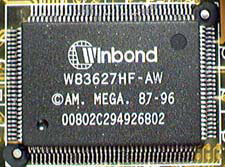Iwill WO2-R Socket 370 i815E + RAID ATX
by Henry Kuo on November 7, 2000 1:04 AM EST- Posted in
- Motherboards
Below the PCI slots is the 82810BA I/O Controller Hub 2 (ICH2), which is what differentiates the i815E chipset from the i815 chipset. The i815 chipset, which uses the 82810AA ICH1, only has Ultra ATA 66 support. The 82810BA ICH2 not only features Ultra ATA 100 support, but also adds a second USB controller and the Intel 82559 network controller.
With the two IDE channels from the AMI RAID controller, users can connect a total of eight Ultra ATA 100 devices, which should be more than enough for most users. Even if you do not use the RAID functionality, you can just treat the AMI RAID controller as a normal Ultra ATA 100 controller. Iwill was also nice enough to provide two 80-pin IDE cables and one 40-pin IDE cable, so users can connect up to four Ultra ATA 100 devices and two ATA 33 devices right out of the box.
When it come to overclocking, Iwill has introduced a feature they like to call "Microstepping," which allow the FSB to be adjusted in 1 MHz increments. In the BIOS, you'll find what they refer to as "ByeBye Jumper Iwill Smart Settings." Here, you can find all the FSB settings available, which is 66 - 200 MHz in 1 MHz increments. Our board was originally using a BIOS dated 7/10/2000 that only had a few FSB settings available, and they were dependent on the default speed of the CPU. However, with a simple BIOS flash to the one dated 9/25/2000, all the FSB settings appear. Since Intel processors are all multiplier locked, this wide range of FSB settings provides you with all the control you'll need to push your CPU to the limit.
Iwill understands that FSB settings are not enough for ultimate overclocking, so they also provide some voltage tweaking for core voltage and I/O voltage. Unfortunately, for the processor core voltage, users are only allowed to choose default, +5%, or +10%. We would prefer to have some more intermediate settings so users can have better overclocking results. For the I/O voltages, you can either choose the 3.4V default, +5%, or +10%. We have yet to see evidence where I/O voltage can be helpful in overclocking, but it might come in handy under the right circumstances. Perhaps in an attempt to dissuade users from using the voltage tweaking features, they've made them less user-friendly than the rest of the CPU setup, forcing you to get your hands dirty with physical jumpers on the motherboard.
 The
WO2-R uses the Winbond W83627HF-AW Super I/O controller, which includes integrated
hardware monitoring support. In the PC Health panel of the BIOS, you can read
about the temperature of the CPU via the CPU's on-die thermal diode. Users can
also read two additional temperatures using the external thermistor headers.
Unfortunately, Iwill does not include thermistor cables to take advantage of
those headers. Moreover, there are three fan connectors on the motherboard that
are all monitored through the PC Health panel. Last of all, the CPU core voltage
is shown in the panel, but not the AGP voltage.
The
WO2-R uses the Winbond W83627HF-AW Super I/O controller, which includes integrated
hardware monitoring support. In the PC Health panel of the BIOS, you can read
about the temperature of the CPU via the CPU's on-die thermal diode. Users can
also read two additional temperatures using the external thermistor headers.
Unfortunately, Iwill does not include thermistor cables to take advantage of
those headers. Moreover, there are three fan connectors on the motherboard that
are all monitored through the PC Health panel. Last of all, the CPU core voltage
is shown in the panel, but not the AGP voltage.
To ensure the board is stable, Iwill put a total of 13 1500uF capacitors around the Socket-370 interface. The result of this work is that the WO2-R was a little above average in our stability tests. Some of the capacitors are a bit close to the CPU socket, which may prevent the installation of oversized HSF units. It also implies that the oversized FC-PGA-C coolers, which are required for 1GHz and above processors, might not work with this motherboard.
The 82815 Graphic and Memory Controller Hub (GMCH), which is the core of the i815 chipset, sits to the left of the CPU socket. It features integrated i752-based 3D video. One serial port is replaced by the VGA connector at the back of the motherboard. However, from our Intel i815 chipset article, you can see that the integrated i752 performs quite poorly. It should be enough for most users who do not use any 3D accelerated applications, but for everyone else, the on-board video is definitely not acceptable. Fortunately, an AGP slot is provided allowing you to install any video. The AGP slot is a "universal slot," meaning that you can put in almost any AGP card. Since the on-board VGA connector replaces one serial port, Iwill puts the second serial port connector above the forth and fifth PCI slots, and they include the necessary serial port bracket.










0 Comments
View All Comments